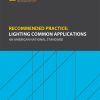Recommended Practice: Lighting for Interior and Exterior Residential Environments
$120.00
Member Price: $90.00
ANSI/IES RP-11-20
Document Type: Recommended Practice (RP)
Available as a downloadable secure PDF only.
To stay current with all IES standards, we recommend subscribing to the The Lighting Library as an Individual or through your company as a Sustaining Member.
In stock
Product Description
 A residence is both a person’s own private space and a venue for entertaining relatives and friends. When the owner residents and their preferences are known ahead of time, proper lighting techniques are employed to address how they will use their home, accommodating everyday likes and dislikes and fulfilling specific wishes to give the owners a better living environment. When the home or living space is designed without knowledge of who its eventual occupants will be, the lighting design can still employ design techniques and strategies to create a space that will be acceptable and appreciated by the majority of its occupants. This document is a guide for designing and for teaching lighting. It covers residential living spaces and other areas intended to impart a residential atmosphere. It describes design objectives, criteria for quantity and quality of illuminance, lighting methods, types and uses of equipment, energy use, and electrical code considerations. Various solutions that address residential lighting problems are also presented.
A residence is both a person’s own private space and a venue for entertaining relatives and friends. When the owner residents and their preferences are known ahead of time, proper lighting techniques are employed to address how they will use their home, accommodating everyday likes and dislikes and fulfilling specific wishes to give the owners a better living environment. When the home or living space is designed without knowledge of who its eventual occupants will be, the lighting design can still employ design techniques and strategies to create a space that will be acceptable and appreciated by the majority of its occupants. This document is a guide for designing and for teaching lighting. It covers residential living spaces and other areas intended to impart a residential atmosphere. It describes design objectives, criteria for quantity and quality of illuminance, lighting methods, types and uses of equipment, energy use, and electrical code considerations. Various solutions that address residential lighting problems are also presented.
Purchase includes RP-10-20+E1: Lighting Common Applications
Page count: 89 pages
Publisher: Illuminating Engineering Society (2020)
SKU: ANSIE/IES/ALA RP-11-20
ISBN-13: 978-0-87995-118-4
Chapters:
- 1.0 Introduction and Scope
2.0 Factors Affecting the Lighting Plan
3.0 Lighting Criteria
4.0 Light and Color
5.0 Quantity of Light
6.0 Basic Lighting Design Techniques
7.0 Light Sources
8.0 Design Techniques for Visual Tasks
9.0 Lighting Equipment and Applications
10.0 Lighting Controls
Citation Format:
Illuminating Engineering Society. ANSIE/IES/ALA RP-11-20, Recommended Practice: Lighting for Interior and Exterior Residential Environments.An American National Standard.
CONTENTS
- 1.0 Introduction and Scope
- 1.1 Introduction
- 1.2 Scope
- 2.0 Factors Affecting the Lighting Plan
- 2.1 Programming
- 2.2 Architectural and Interior Elements
- 2.3 Exterior Elements
- 2.4 Function
- 2.5 Resilient Lighting
- 3.0 Lighting Criteria
- 3.1 Quality of Light: Aesthetics, Beauty, Comfort
- 3.2 Reflectance and Glare
- 3.3 Flattering Light
- 3.4 Brightness Association
- 3.5 Ultraviolet (UV) and Infrared (IR) Concerns
- 3.6 Visual Impressions
- 3.7 Expanding the Space – Bringing the Outdoors in
- 3.8 Safety in the Expanded (Exterior) Space
- 4.0 Light and Color
- 4.1 Color Recognition
- 4.2 Correlated Color Temperature (CCT) of a Light Source
- 4.3 Object Color
- 4.4 Color Rendition
- 4.5 Surface Finish
- 4.6 Fading
- 4.7 Metamers
- 4.8 The Munsell System
4.8.1 Hue
4.8.2 Value
4.8.3 Chroma - 5.0 Quantity of Light
- 5.1 Illuminance Selection
- 5.2 Illuminance Tables
- 6.0 Basic Lighting Design Techniques
- 6.1 Layering Light
- 6.2 Task Lighting
- 6.3 Downlighting
- 6.4 Vertical Surfaces
6.4.1 Wall Washing
6.4.2 Grazing - 6.5 Accent Lighting
- 6.6 Indirect Lighting
- 6.7 Cove Lighting
- 7.0 Light Sources
- 7.1 Daylight
7.1.1 Daylight Performance Parameters
7.1.2 Daylight Design Decisions
7.1.3 Daylight Delivery Methods - 7.2 Light Emitting Diode (LED) Light Sources
- 7.3 Fluorescent Light Sources
- 7.4 Incandescent Light Sources
7.4.1 Energy Independence and Security Act (EISA) of 2007 - 7.5 Tungsten-Halogen Light Sources
- 7.6 Low-Voltage Incandescent and Halogen Light Sources
- 7.7 Cold Cathode and Neon Light Sources
- 7.8 Ultraviolet (UV) Radiation
- 8.0 Design Techniques for Visual Tasks
- 8.1 Grooming at a Mirror
- 8.2 Full Length Mirror
- 8.3 Desk with Computer
- 8.4 Reading in Bed
- 8.5 Kitchens
- 8.5.1 Kitchen Sink
- 8.6 Ironing
- 8.7 Dining Areas and Eating Surfaces
- 8.8 Stairs
- 8.9 Emergency Lighting
- 9.0 Lighting Equipment and Applications
- 9.1 Luminaire Look, Style, and Impact
- 9.2 Recessed Luminaires
9.2.1 Application
9.2.2 Performance
9.2.3 Decorative Considerations - 9.3 Surface-Mounted Ceiling Luminaires
9.3.1 Application - 9.4 Track-Mounted Luminaires
9.4.1 Application
9.4.2 Performance - 9.5 Suspended Luminaires
9.5.1 Pendants
9.5.2 Chandelier
9.5.3 Linear Suspended Luminaires
9.5.4 Decorative Considerations - 9.6 Under-Cabinet Task and Accent Lighting
9.6.1 Application
9.6.2 Performance
9.6.3 Decorative Considerations - 9.7 Wall-Mounted Luminaires
9.7.1 Application
9.7.2 Performance
9.7.3 Decorative Considerations - 9.8 Portable Luminaires
9.8.1 Application
9.8.2 Performance
9.8.3 Decorative Considerations - 9.9 Integrated Lighting and Linear Systems
- 10.0 Lighting Controls
- 10.1 General Considerations
10.1.1 Traditional Controls
10.1.2 Home Automation
10.1.3 Homeowners and Technology
10.1.4 Zero Net Energy Homes
10.1.5 Identifying the Right Control System for the Job - 10.2 Control Technologies
10.2.1 Wall-Box Controls
10.2.2 Wireless Controls
10.2.3 Dimming Methods
10.2.4 Scene Preset Control and User Interfaces
10.2.5 Central Computer-Controlled Systems versus Distributed Mesh Networks



